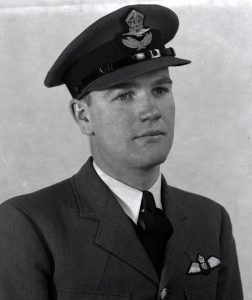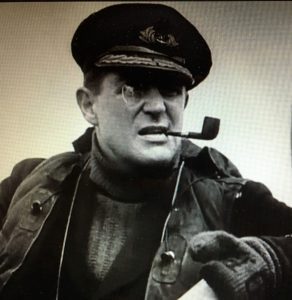
His first job in the RCAF in the Second World War was training young military aircrew for combat. U-boats, the submarines of the German Kriegsmarine (war navy), had descended like wolf packs on merchant shipping off the coast of Nova Scotia since 1940 – sinking upwards of 300,000 tons of freight destined for Britain each month.
So, Canadian bomber pilot Norville Everett (Molly) Small had to teach his green bomber crews not only how to handle their aircraft, but also how to surprise and try to sink U-boats on the Atlantic. He and his Canso (flying boat) crew got their first opportunity on April 28, 1942. They attempted to drop bombs on an unsuspecting U-boat. The bombs exploded, but wide of the target.
“The captain of the aircraft,” Molly Small later reported drily of his attack, “feels though the possibility of a clean kill is not very strong, he is certain that he made their back teeth rattle. He’ll do better next time.”
Canadians don’t often enough associate serving one’s country in the armed services as heroic. And yes, thousands of young women and men received volunteer gongs (medals) for serving Canada and Britain during the Great War and Second World War.
Beyond that, 99 Canadians have received the Victoria Cross, the highest award in the United Kingdom for “gallantry in the face of the enemy.” Alexander Dunn charged on horseback with the Light Brigade during the Crimean War in 1854, and became the first Canadian to receive the VC; while in 1944, Ernest (Smokey) Smith single handedly fought off German tanks and soldiers during the liberation of Italy, and became the only Canadian private to be awarded the VC. Since 1945, no Canadians have received the decoration.
When S/L Small promised he’d do better next time, he was true to his word. After failing to deliver a coup de grâce versus the U-boat in April 1942, he re-evaluated Air Force anti-submarine tactics off the coast of Canada. He’d learned by trial and error that bombs with contact fuses were useless against U-boats; however, depth charges triggered by water pressure (hydrostatic detonation at a specific depth) would inflict more damage.
In addition, he recognized that Allied aircraft – generally painted with dark colours – might be less visible in the sky if their undersides were painted white instead. He noted that attacking from high altitude – from 5,000 feet instead of 100 feet – would also increase the element of surprise.
In July 1942, he and his Hudson bomber crew caught U754 unawares. Unnoticed by the U-boat crew, Small dove from altitude and released a cluster of depth charges straddling the submarine.
“Fifty-five minutes later,” his report noted, “a further heavy explosion took place where the depth charges had exploded,” and Small’s crew became the first anti-submarine aircraft crew in the RCAF to destroy a U-boat.

James Douglas (Chummy) Prentice, formerly a B.C. rancher, applied the same powers of deduction and re-evaluation while training Royal Canadian Navy crews against the marauding U-boats on the surface of the Atlantic.
As commander of HMCS Chambly, and responsible for teaching crews aboard RCN corvettes the tools of escorting merchant ships safely from Canada to the U.K., Prentice recognized and respected that escorts had to defend the convoys first and foremost. But he also knew that a corvette’s agility and punch could match a U-boat on the surface, and when called upon, “our job will be to find the enemy and kill him,” that is, not as defensive convoy sheepdogs, but as proactive sub-killers.
Prentice taught his corvette crews to resist the inclination of accelerating toward a U-boat when sighted, but to work in measured tandem with a partner warship – one plotting the U-boat with ASDIC (early sonar), the other delivering depth charges with greater precision.
The savvy commander also realized by training his crews farther at sea (i.e. closer to the North Atlantic war zone) that his corvettes could use newly their practised tactics immediately – learning on the job as it were – to greater effect. His strategy worked, when on Sept. 9, 1941, Chambly and sister ship Moose Jaw raced to the aid of Convoy SC 42 and chased U501 to exhaustion, giving the Royal Canadian Navy its first corvette U-boat kill of the war.
Prentice’s Royal Navy comrades were amused that the corvette commander (and former rancher) had employed “cowboy convoy defence” to accomplish a task. Prentice called it, “keeping the enemy well stirred up.”
Few histories of the longest battle of the war – the Battle of the Atlantic – refer to two of its most capable tacticians as heroes. But for competence and courage under fire, in my books Molly Small and Chummy Prentice certainly qualify.
Thanks Ted Barris, I came across this article when I was searching for something about my Grandpa P (Chummy Prentice) to send to my son who’s away at university this Remembrance Day. A perfect piece to bring home what it means to our family and our nation on this day. I’ll look for your new book to keep on the coffee table over Christmas when our boy is home for the holidays. Thanks again!
Hello Ted! Steve Glover, Public Relations Officer with the Royal Cdn. (Barrie) Legion. We had you speak here on the Dam Busters and the Great Escape a few years ago. I was registered to attend your talk on the Battle of the Atlantic at Georgian College in September but tested positive for Covid a few days before! But I made sure Barrie Legion FaceBook followers were aware of your talk. One of the attendees lent me his copy of your new book on the Battle of the Atlantic and I am enjoying it. Just learned about Molly Small who was from Allandale (now part of Barrie). I am inquiring to see if you might be available for a 2023 date at the Barrie Legion – May or June timeframe?